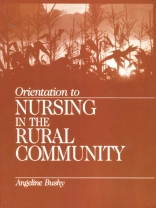More and more, health care in America is being delivered in community-based facilities. With this change in our health care system comes a greater awareness among educators to expose students in the health professions to rural clients and rural environments and make them aware of the challenges still faced by rural health professionals. Orientation to Nursing in the Rural Community examines the evolving health care delivery systems and role of nursing within the rural context. Divided into three parts including perspectives from experts in Australia and Canada, the book covers the foundations of rural nursing, special populations, and future perspectives. Students of nursing will find special features in each chapter extremely helpful: such as a list of objectives, key terms, points to remember, suggested research activities, and discussion questions.
Table des matières
PART ONE: FOUNDATIONS OF RURAL NURSING
Nursing and Rural Health Care Delivery
Yesterday and Today
Definitions of
Rural and Their Implications
Theoretical Foundations for Nursing in Rural Environments
The Community Health Assessment (CHA) Process
Building Partnerships
Exemplar
A Framework for Rural Nursing Interventions
PART TWO: SPECIAL POPULATIONS
Special and At-Risk Rural Populations
Cultural-Linguistic Competence
Rural Considerations
Behavioral Health Care
Rural Issues and Strategies
America′s Lost Population
The Rural Homeless
HIV/AIDS
The Silent Enemy Within Rural Communities
Rural Occupational, Safety, Health and Nursing
PART THREE: NATIONAL AND GLOBAL FUTURISTIC PERSPECTIVES
The Meaning of Managed Care for Rural America
Rural Nursing in the United States
Rural Nursing in Australia
Rural Nursing in Canada
Analysis of Rural Nursing
Australia, Canada, United States
Ethical Situations
What Nurses in Rural in Practice Should Know
Research
The Link Between Rural Theory & Evidence-Based Practice












